Organizational Change: Nokia and JCP Case Study Analysis Report
VerifiedAdded on 2022/09/07
|11
|2391
|21
Report
AI Summary
This report examines the impact of organizational change on business operations and strategy, focusing on the case studies of Nokia and J.C. Penney (JCP). It explores the external and internal drivers of change, analyzing how factors such as technological advancements, economic recessions, and leadership decisions influenced these companies. The report delves into the challenges faced, including structural changes, market disruptions, and shifts in consumer behavior. It highlights both the positive and negative consequences of these changes, assessing how these changes affected individual, team, and leadership behaviour. Furthermore, the report suggests the application of change management models, such as Kotter's transformational model and Kurt Lewin's change theory model, to mitigate the negative impacts of change and improve organizational performance. The analysis provides valuable insights into the complexities of change management and offers strategies for navigating organizational transformations.
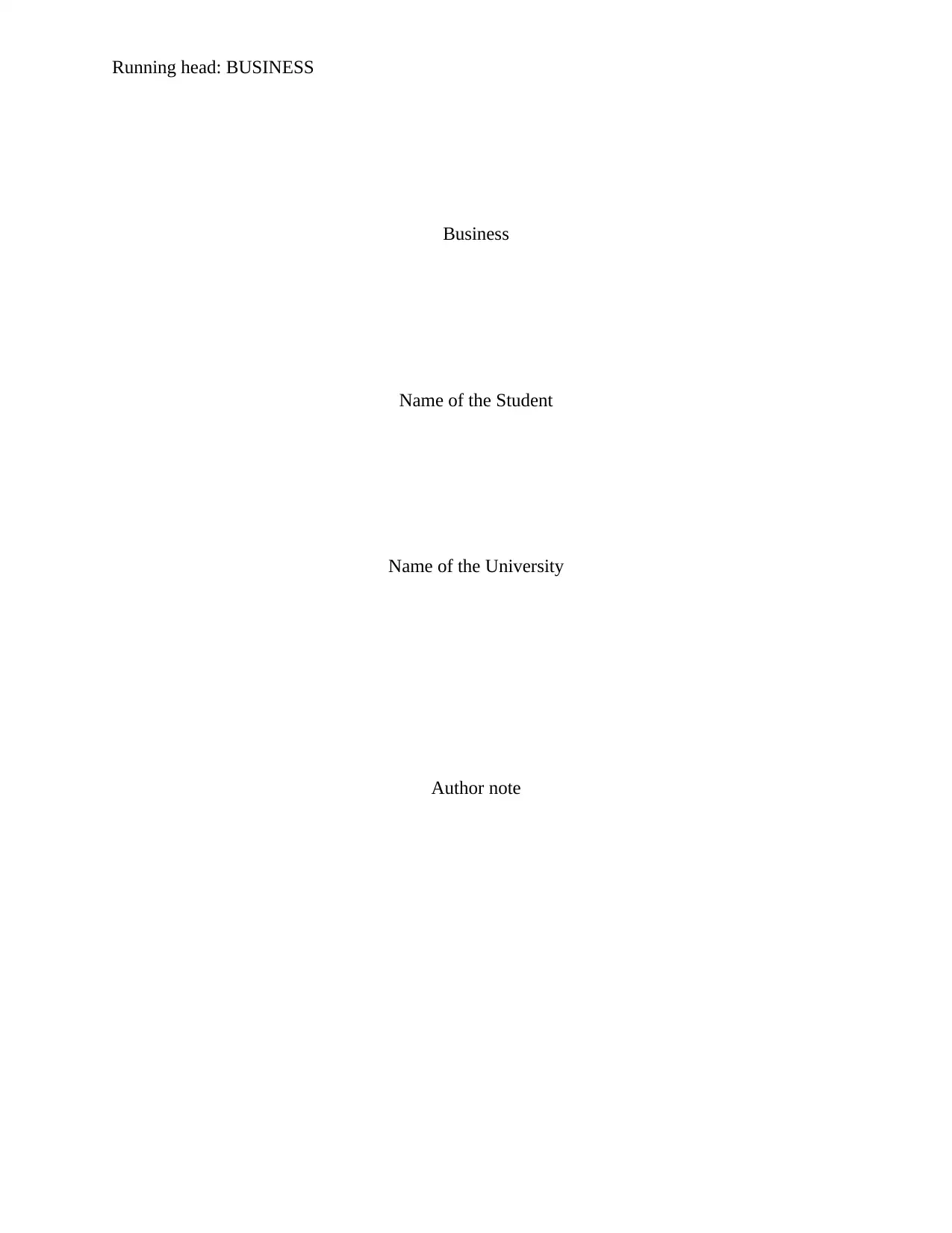
Running head: BUSINESS
Business
Name of the Student
Name of the University
Author note
Business
Name of the Student
Name of the University
Author note
Paraphrase This Document
Need a fresh take? Get an instant paraphrase of this document with our AI Paraphraser
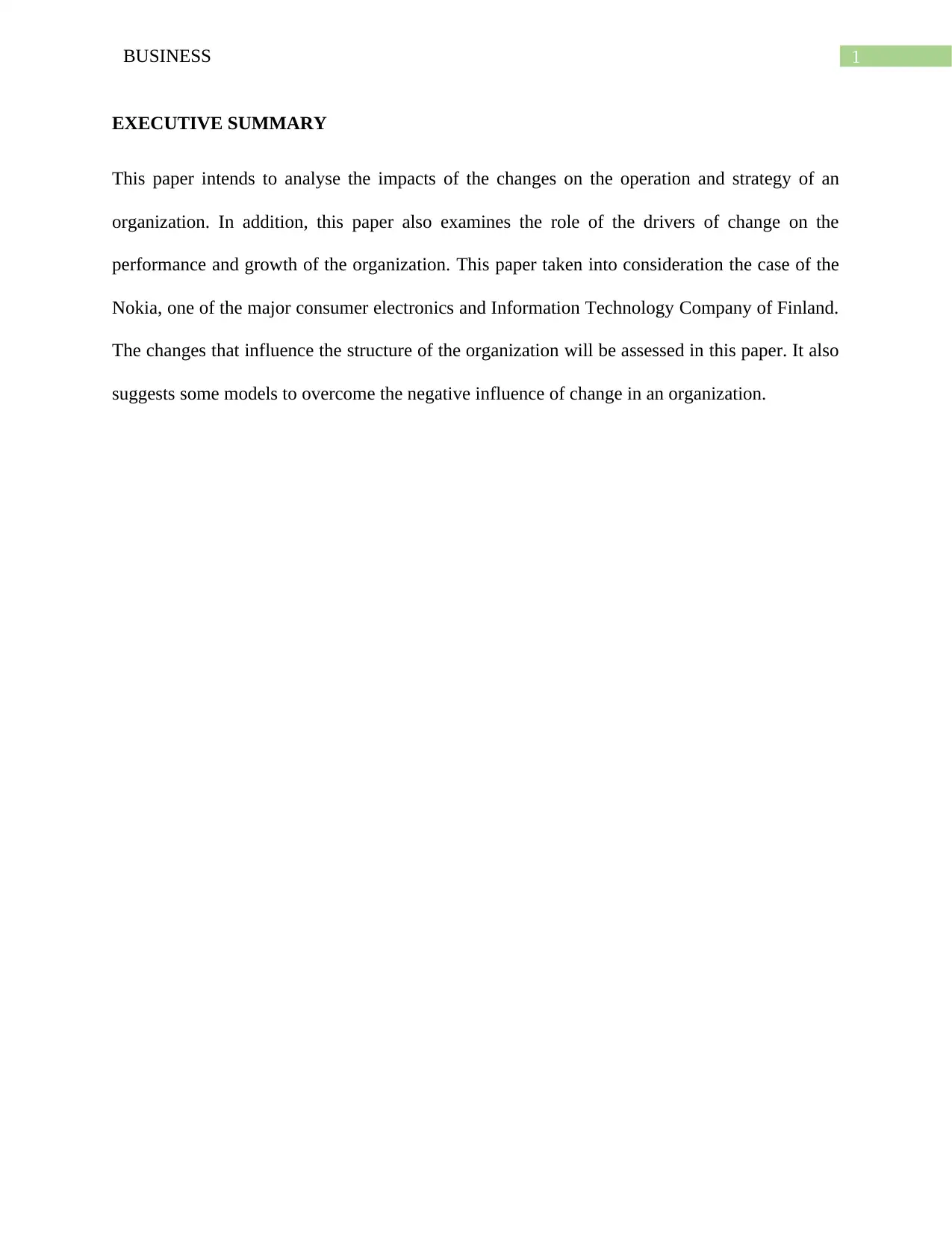
1BUSINESS
EXECUTIVE SUMMARY
This paper intends to analyse the impacts of the changes on the operation and strategy of an
organization. In addition, this paper also examines the role of the drivers of change on the
performance and growth of the organization. This paper taken into consideration the case of the
Nokia, one of the major consumer electronics and Information Technology Company of Finland.
The changes that influence the structure of the organization will be assessed in this paper. It also
suggests some models to overcome the negative influence of change in an organization.
EXECUTIVE SUMMARY
This paper intends to analyse the impacts of the changes on the operation and strategy of an
organization. In addition, this paper also examines the role of the drivers of change on the
performance and growth of the organization. This paper taken into consideration the case of the
Nokia, one of the major consumer electronics and Information Technology Company of Finland.
The changes that influence the structure of the organization will be assessed in this paper. It also
suggests some models to overcome the negative influence of change in an organization.
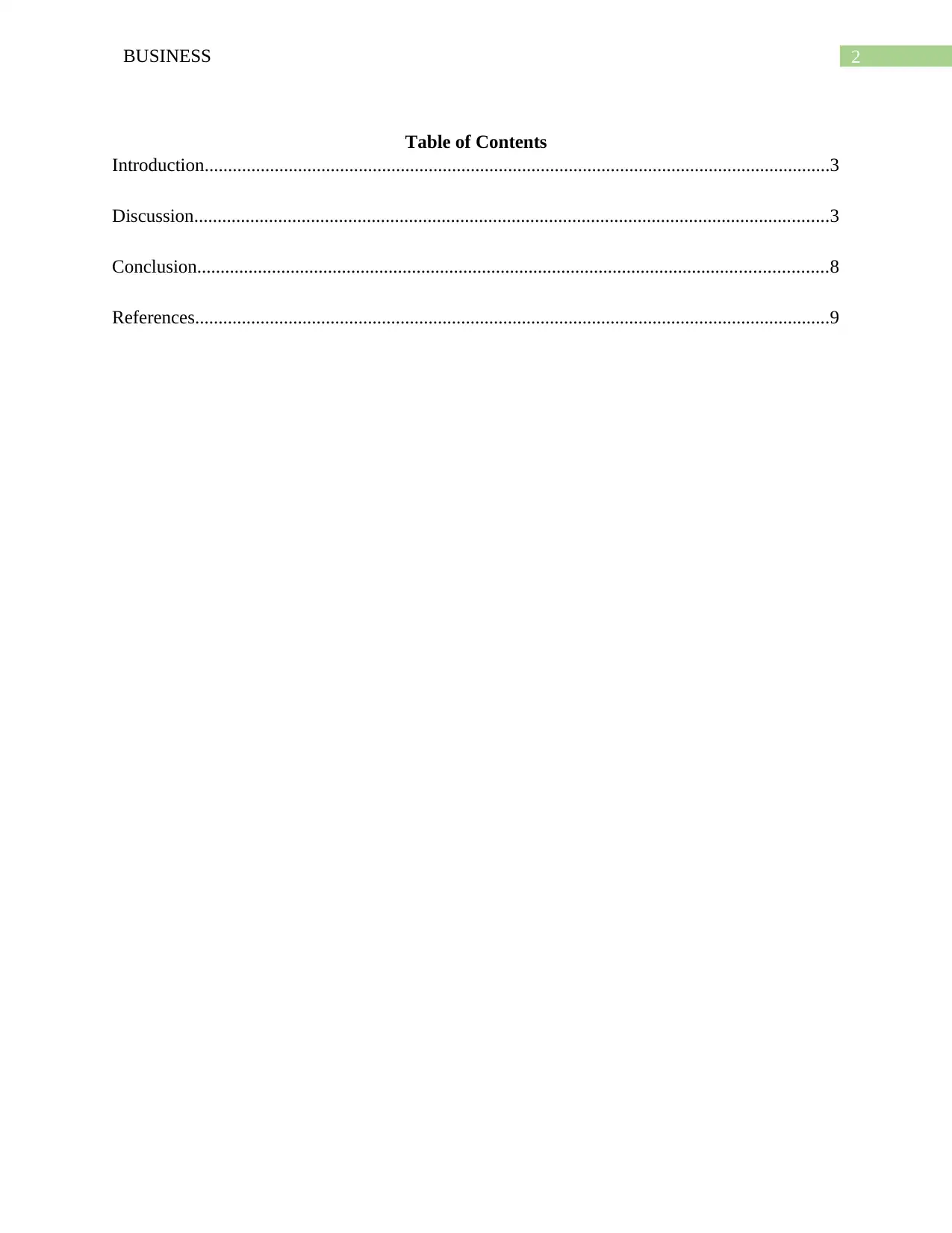
2BUSINESS
Table of Contents
Introduction......................................................................................................................................3
Discussion........................................................................................................................................3
Conclusion.......................................................................................................................................8
References........................................................................................................................................9
Table of Contents
Introduction......................................................................................................................................3
Discussion........................................................................................................................................3
Conclusion.......................................................................................................................................8
References........................................................................................................................................9
⊘ This is a preview!⊘
Do you want full access?
Subscribe today to unlock all pages.

Trusted by 1+ million students worldwide
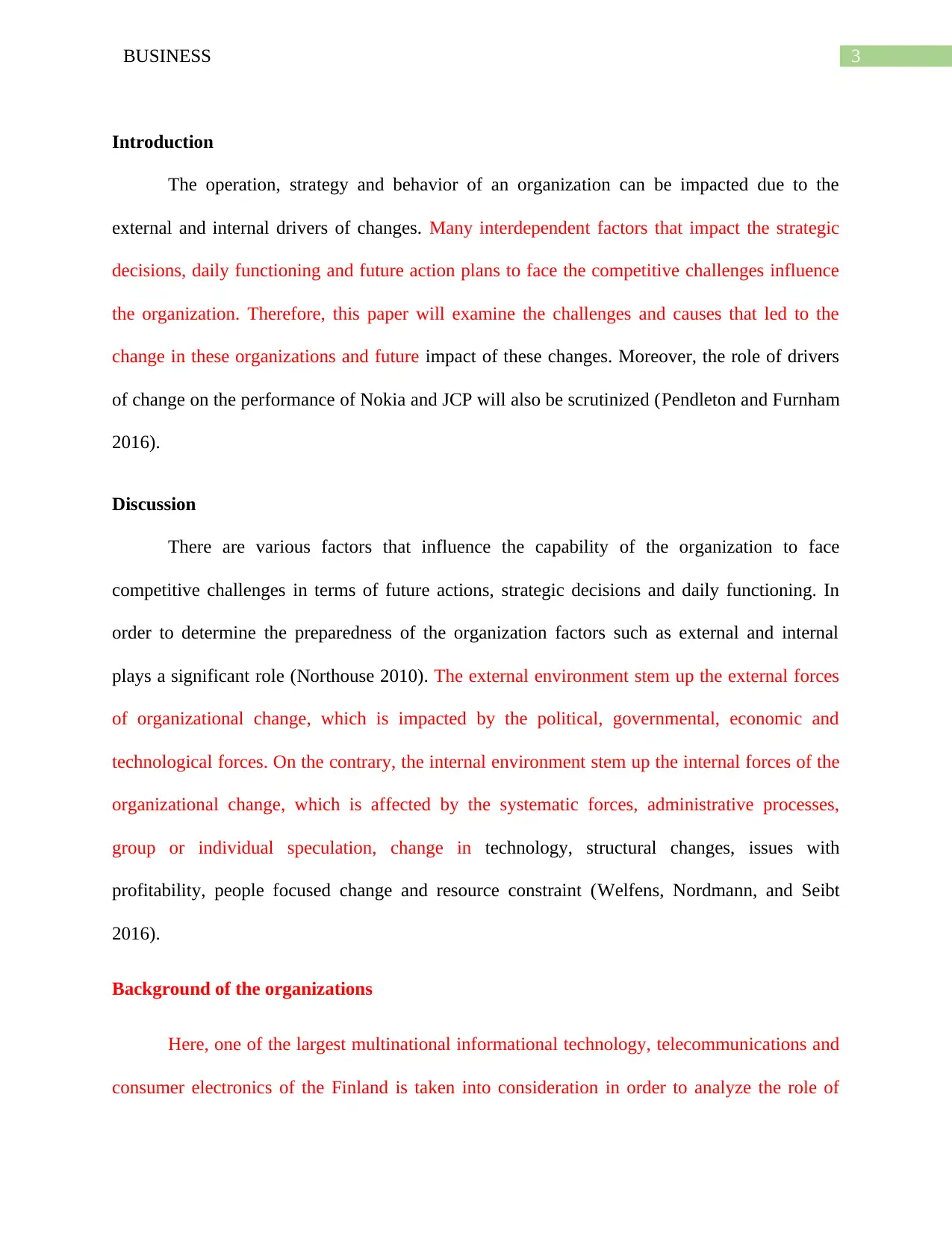
3BUSINESS
Introduction
The operation, strategy and behavior of an organization can be impacted due to the
external and internal drivers of changes. Many interdependent factors that impact the strategic
decisions, daily functioning and future action plans to face the competitive challenges influence
the organization. Therefore, this paper will examine the challenges and causes that led to the
change in these organizations and future impact of these changes. Moreover, the role of drivers
of change on the performance of Nokia and JCP will also be scrutinized (Pendleton and Furnham
2016).
Discussion
There are various factors that influence the capability of the organization to face
competitive challenges in terms of future actions, strategic decisions and daily functioning. In
order to determine the preparedness of the organization factors such as external and internal
plays a significant role (Northouse 2010). The external environment stem up the external forces
of organizational change, which is impacted by the political, governmental, economic and
technological forces. On the contrary, the internal environment stem up the internal forces of the
organizational change, which is affected by the systematic forces, administrative processes,
group or individual speculation, change in technology, structural changes, issues with
profitability, people focused change and resource constraint (Welfens, Nordmann, and Seibt
2016).
Background of the organizations
Here, one of the largest multinational informational technology, telecommunications and
consumer electronics of the Finland is taken into consideration in order to analyze the role of
Introduction
The operation, strategy and behavior of an organization can be impacted due to the
external and internal drivers of changes. Many interdependent factors that impact the strategic
decisions, daily functioning and future action plans to face the competitive challenges influence
the organization. Therefore, this paper will examine the challenges and causes that led to the
change in these organizations and future impact of these changes. Moreover, the role of drivers
of change on the performance of Nokia and JCP will also be scrutinized (Pendleton and Furnham
2016).
Discussion
There are various factors that influence the capability of the organization to face
competitive challenges in terms of future actions, strategic decisions and daily functioning. In
order to determine the preparedness of the organization factors such as external and internal
plays a significant role (Northouse 2010). The external environment stem up the external forces
of organizational change, which is impacted by the political, governmental, economic and
technological forces. On the contrary, the internal environment stem up the internal forces of the
organizational change, which is affected by the systematic forces, administrative processes,
group or individual speculation, change in technology, structural changes, issues with
profitability, people focused change and resource constraint (Welfens, Nordmann, and Seibt
2016).
Background of the organizations
Here, one of the largest multinational informational technology, telecommunications and
consumer electronics of the Finland is taken into consideration in order to analyze the role of
Paraphrase This Document
Need a fresh take? Get an instant paraphrase of this document with our AI Paraphraser
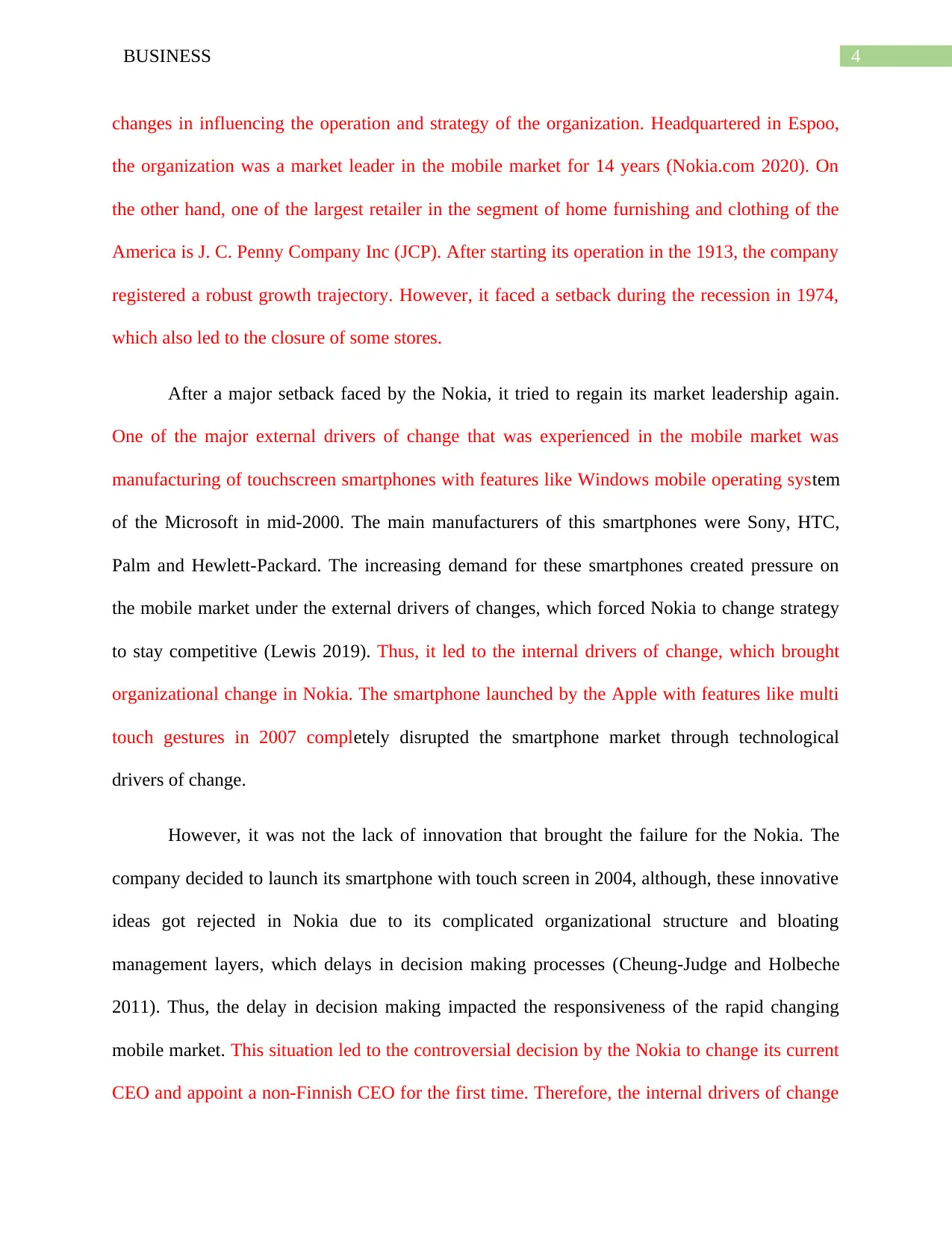
4BUSINESS
changes in influencing the operation and strategy of the organization. Headquartered in Espoo,
the organization was a market leader in the mobile market for 14 years (Nokia.com 2020). On
the other hand, one of the largest retailer in the segment of home furnishing and clothing of the
America is J. C. Penny Company Inc (JCP). After starting its operation in the 1913, the company
registered a robust growth trajectory. However, it faced a setback during the recession in 1974,
which also led to the closure of some stores.
After a major setback faced by the Nokia, it tried to regain its market leadership again.
One of the major external drivers of change that was experienced in the mobile market was
manufacturing of touchscreen smartphones with features like Windows mobile operating system
of the Microsoft in mid-2000. The main manufacturers of this smartphones were Sony, HTC,
Palm and Hewlett-Packard. The increasing demand for these smartphones created pressure on
the mobile market under the external drivers of changes, which forced Nokia to change strategy
to stay competitive (Lewis 2019). Thus, it led to the internal drivers of change, which brought
organizational change in Nokia. The smartphone launched by the Apple with features like multi
touch gestures in 2007 completely disrupted the smartphone market through technological
drivers of change.
However, it was not the lack of innovation that brought the failure for the Nokia. The
company decided to launch its smartphone with touch screen in 2004, although, these innovative
ideas got rejected in Nokia due to its complicated organizational structure and bloating
management layers, which delays in decision making processes (Cheung-Judge and Holbeche
2011). Thus, the delay in decision making impacted the responsiveness of the rapid changing
mobile market. This situation led to the controversial decision by the Nokia to change its current
CEO and appoint a non-Finnish CEO for the first time. Therefore, the internal drivers of change
changes in influencing the operation and strategy of the organization. Headquartered in Espoo,
the organization was a market leader in the mobile market for 14 years (Nokia.com 2020). On
the other hand, one of the largest retailer in the segment of home furnishing and clothing of the
America is J. C. Penny Company Inc (JCP). After starting its operation in the 1913, the company
registered a robust growth trajectory. However, it faced a setback during the recession in 1974,
which also led to the closure of some stores.
After a major setback faced by the Nokia, it tried to regain its market leadership again.
One of the major external drivers of change that was experienced in the mobile market was
manufacturing of touchscreen smartphones with features like Windows mobile operating system
of the Microsoft in mid-2000. The main manufacturers of this smartphones were Sony, HTC,
Palm and Hewlett-Packard. The increasing demand for these smartphones created pressure on
the mobile market under the external drivers of changes, which forced Nokia to change strategy
to stay competitive (Lewis 2019). Thus, it led to the internal drivers of change, which brought
organizational change in Nokia. The smartphone launched by the Apple with features like multi
touch gestures in 2007 completely disrupted the smartphone market through technological
drivers of change.
However, it was not the lack of innovation that brought the failure for the Nokia. The
company decided to launch its smartphone with touch screen in 2004, although, these innovative
ideas got rejected in Nokia due to its complicated organizational structure and bloating
management layers, which delays in decision making processes (Cheung-Judge and Holbeche
2011). Thus, the delay in decision making impacted the responsiveness of the rapid changing
mobile market. This situation led to the controversial decision by the Nokia to change its current
CEO and appoint a non-Finnish CEO for the first time. Therefore, the internal drivers of change
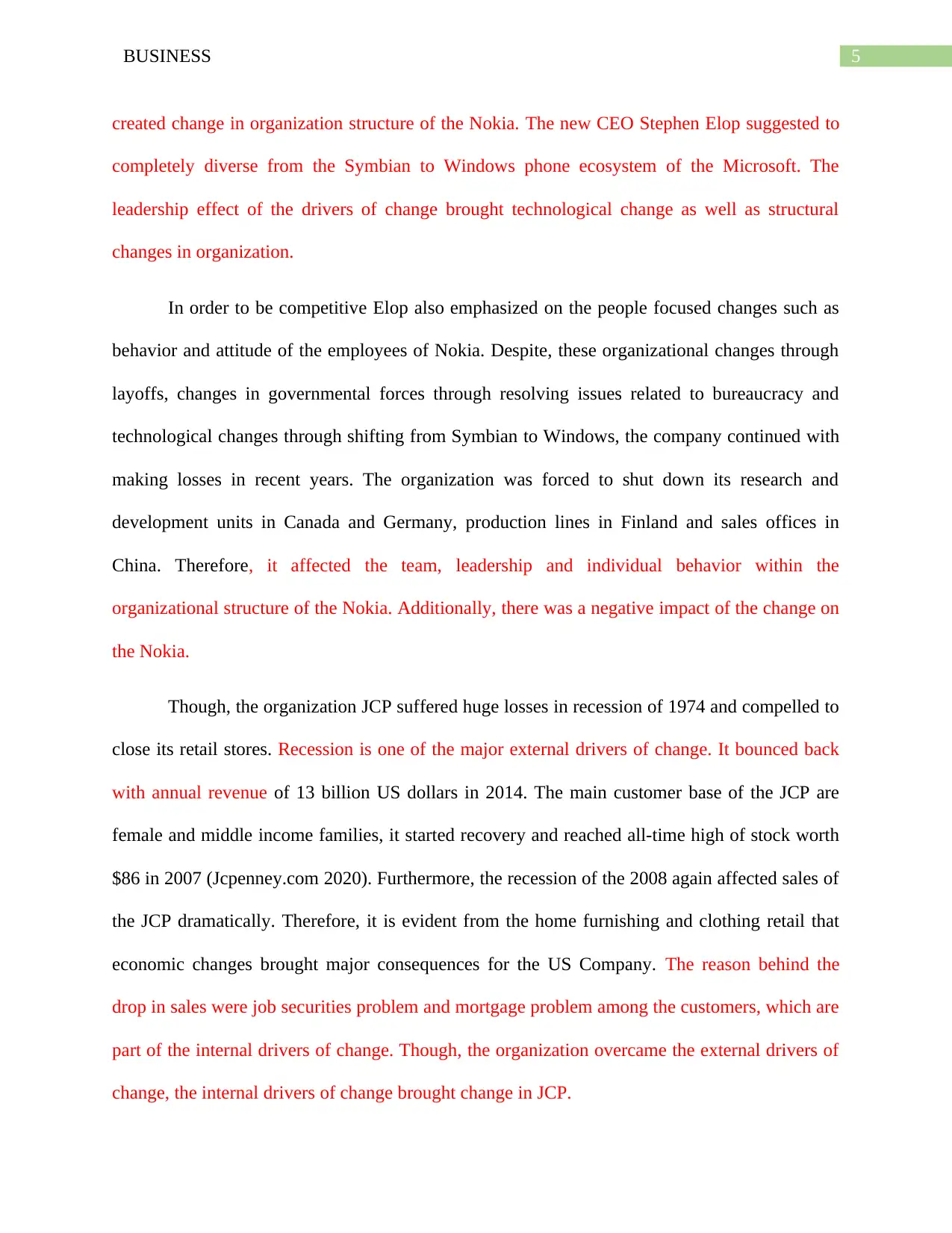
5BUSINESS
created change in organization structure of the Nokia. The new CEO Stephen Elop suggested to
completely diverse from the Symbian to Windows phone ecosystem of the Microsoft. The
leadership effect of the drivers of change brought technological change as well as structural
changes in organization.
In order to be competitive Elop also emphasized on the people focused changes such as
behavior and attitude of the employees of Nokia. Despite, these organizational changes through
layoffs, changes in governmental forces through resolving issues related to bureaucracy and
technological changes through shifting from Symbian to Windows, the company continued with
making losses in recent years. The organization was forced to shut down its research and
development units in Canada and Germany, production lines in Finland and sales offices in
China. Therefore, it affected the team, leadership and individual behavior within the
organizational structure of the Nokia. Additionally, there was a negative impact of the change on
the Nokia.
Though, the organization JCP suffered huge losses in recession of 1974 and compelled to
close its retail stores. Recession is one of the major external drivers of change. It bounced back
with annual revenue of 13 billion US dollars in 2014. The main customer base of the JCP are
female and middle income families, it started recovery and reached all-time high of stock worth
$86 in 2007 (Jcpenney.com 2020). Furthermore, the recession of the 2008 again affected sales of
the JCP dramatically. Therefore, it is evident from the home furnishing and clothing retail that
economic changes brought major consequences for the US Company. The reason behind the
drop in sales were job securities problem and mortgage problem among the customers, which are
part of the internal drivers of change. Though, the organization overcame the external drivers of
change, the internal drivers of change brought change in JCP.
created change in organization structure of the Nokia. The new CEO Stephen Elop suggested to
completely diverse from the Symbian to Windows phone ecosystem of the Microsoft. The
leadership effect of the drivers of change brought technological change as well as structural
changes in organization.
In order to be competitive Elop also emphasized on the people focused changes such as
behavior and attitude of the employees of Nokia. Despite, these organizational changes through
layoffs, changes in governmental forces through resolving issues related to bureaucracy and
technological changes through shifting from Symbian to Windows, the company continued with
making losses in recent years. The organization was forced to shut down its research and
development units in Canada and Germany, production lines in Finland and sales offices in
China. Therefore, it affected the team, leadership and individual behavior within the
organizational structure of the Nokia. Additionally, there was a negative impact of the change on
the Nokia.
Though, the organization JCP suffered huge losses in recession of 1974 and compelled to
close its retail stores. Recession is one of the major external drivers of change. It bounced back
with annual revenue of 13 billion US dollars in 2014. The main customer base of the JCP are
female and middle income families, it started recovery and reached all-time high of stock worth
$86 in 2007 (Jcpenney.com 2020). Furthermore, the recession of the 2008 again affected sales of
the JCP dramatically. Therefore, it is evident from the home furnishing and clothing retail that
economic changes brought major consequences for the US Company. The reason behind the
drop in sales were job securities problem and mortgage problem among the customers, which are
part of the internal drivers of change. Though, the organization overcame the external drivers of
change, the internal drivers of change brought change in JCP.
⊘ This is a preview!⊘
Do you want full access?
Subscribe today to unlock all pages.

Trusted by 1+ million students worldwide
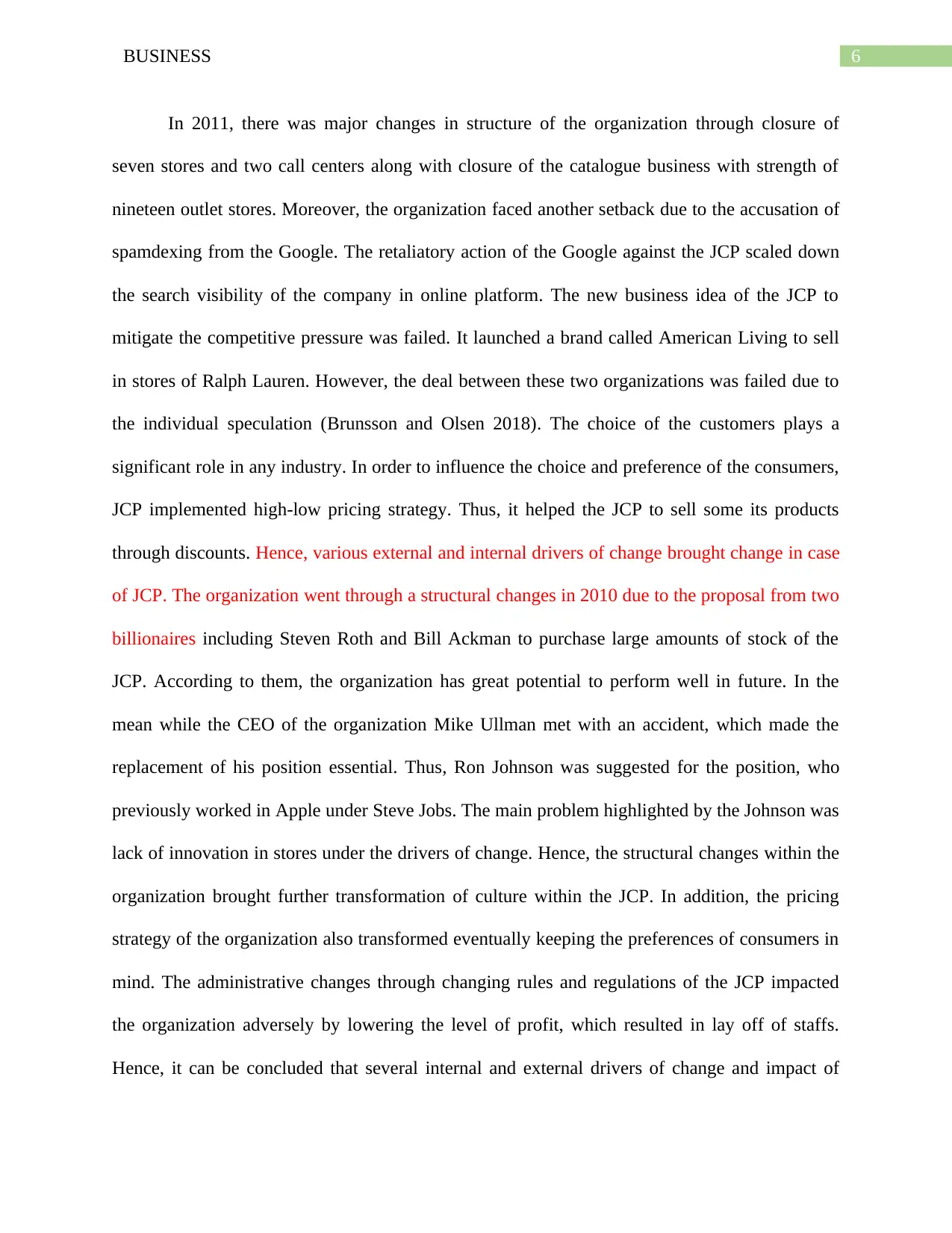
6BUSINESS
In 2011, there was major changes in structure of the organization through closure of
seven stores and two call centers along with closure of the catalogue business with strength of
nineteen outlet stores. Moreover, the organization faced another setback due to the accusation of
spamdexing from the Google. The retaliatory action of the Google against the JCP scaled down
the search visibility of the company in online platform. The new business idea of the JCP to
mitigate the competitive pressure was failed. It launched a brand called American Living to sell
in stores of Ralph Lauren. However, the deal between these two organizations was failed due to
the individual speculation (Brunsson and Olsen 2018). The choice of the customers plays a
significant role in any industry. In order to influence the choice and preference of the consumers,
JCP implemented high-low pricing strategy. Thus, it helped the JCP to sell some its products
through discounts. Hence, various external and internal drivers of change brought change in case
of JCP. The organization went through a structural changes in 2010 due to the proposal from two
billionaires including Steven Roth and Bill Ackman to purchase large amounts of stock of the
JCP. According to them, the organization has great potential to perform well in future. In the
mean while the CEO of the organization Mike Ullman met with an accident, which made the
replacement of his position essential. Thus, Ron Johnson was suggested for the position, who
previously worked in Apple under Steve Jobs. The main problem highlighted by the Johnson was
lack of innovation in stores under the drivers of change. Hence, the structural changes within the
organization brought further transformation of culture within the JCP. In addition, the pricing
strategy of the organization also transformed eventually keeping the preferences of consumers in
mind. The administrative changes through changing rules and regulations of the JCP impacted
the organization adversely by lowering the level of profit, which resulted in lay off of staffs.
Hence, it can be concluded that several internal and external drivers of change and impact of
In 2011, there was major changes in structure of the organization through closure of
seven stores and two call centers along with closure of the catalogue business with strength of
nineteen outlet stores. Moreover, the organization faced another setback due to the accusation of
spamdexing from the Google. The retaliatory action of the Google against the JCP scaled down
the search visibility of the company in online platform. The new business idea of the JCP to
mitigate the competitive pressure was failed. It launched a brand called American Living to sell
in stores of Ralph Lauren. However, the deal between these two organizations was failed due to
the individual speculation (Brunsson and Olsen 2018). The choice of the customers plays a
significant role in any industry. In order to influence the choice and preference of the consumers,
JCP implemented high-low pricing strategy. Thus, it helped the JCP to sell some its products
through discounts. Hence, various external and internal drivers of change brought change in case
of JCP. The organization went through a structural changes in 2010 due to the proposal from two
billionaires including Steven Roth and Bill Ackman to purchase large amounts of stock of the
JCP. According to them, the organization has great potential to perform well in future. In the
mean while the CEO of the organization Mike Ullman met with an accident, which made the
replacement of his position essential. Thus, Ron Johnson was suggested for the position, who
previously worked in Apple under Steve Jobs. The main problem highlighted by the Johnson was
lack of innovation in stores under the drivers of change. Hence, the structural changes within the
organization brought further transformation of culture within the JCP. In addition, the pricing
strategy of the organization also transformed eventually keeping the preferences of consumers in
mind. The administrative changes through changing rules and regulations of the JCP impacted
the organization adversely by lowering the level of profit, which resulted in lay off of staffs.
Hence, it can be concluded that several internal and external drivers of change and impact of
Paraphrase This Document
Need a fresh take? Get an instant paraphrase of this document with our AI Paraphraser
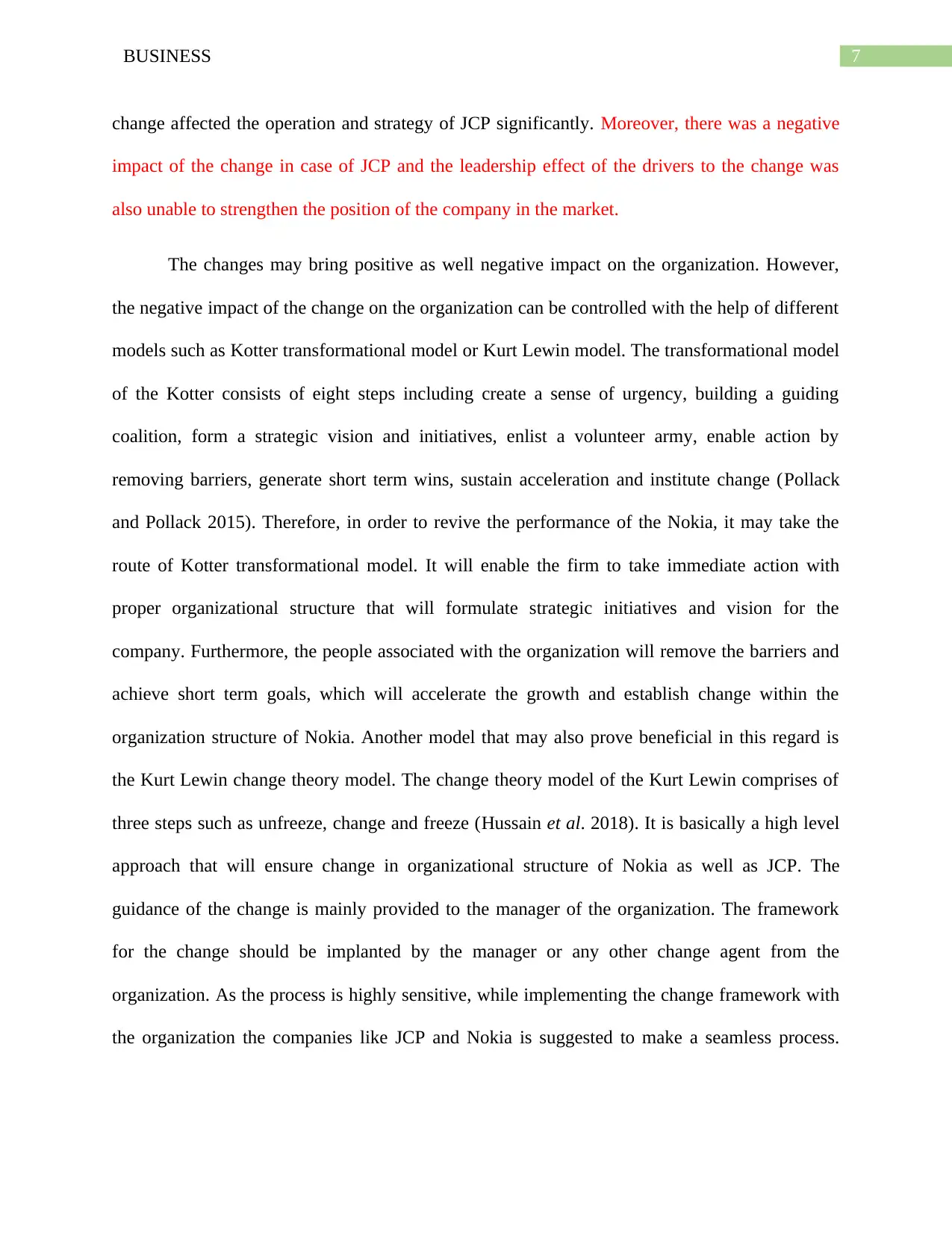
7BUSINESS
change affected the operation and strategy of JCP significantly. Moreover, there was a negative
impact of the change in case of JCP and the leadership effect of the drivers to the change was
also unable to strengthen the position of the company in the market.
The changes may bring positive as well negative impact on the organization. However,
the negative impact of the change on the organization can be controlled with the help of different
models such as Kotter transformational model or Kurt Lewin model. The transformational model
of the Kotter consists of eight steps including create a sense of urgency, building a guiding
coalition, form a strategic vision and initiatives, enlist a volunteer army, enable action by
removing barriers, generate short term wins, sustain acceleration and institute change (Pollack
and Pollack 2015). Therefore, in order to revive the performance of the Nokia, it may take the
route of Kotter transformational model. It will enable the firm to take immediate action with
proper organizational structure that will formulate strategic initiatives and vision for the
company. Furthermore, the people associated with the organization will remove the barriers and
achieve short term goals, which will accelerate the growth and establish change within the
organization structure of Nokia. Another model that may also prove beneficial in this regard is
the Kurt Lewin change theory model. The change theory model of the Kurt Lewin comprises of
three steps such as unfreeze, change and freeze (Hussain et al. 2018). It is basically a high level
approach that will ensure change in organizational structure of Nokia as well as JCP. The
guidance of the change is mainly provided to the manager of the organization. The framework
for the change should be implanted by the manager or any other change agent from the
organization. As the process is highly sensitive, while implementing the change framework with
the organization the companies like JCP and Nokia is suggested to make a seamless process.
change affected the operation and strategy of JCP significantly. Moreover, there was a negative
impact of the change in case of JCP and the leadership effect of the drivers to the change was
also unable to strengthen the position of the company in the market.
The changes may bring positive as well negative impact on the organization. However,
the negative impact of the change on the organization can be controlled with the help of different
models such as Kotter transformational model or Kurt Lewin model. The transformational model
of the Kotter consists of eight steps including create a sense of urgency, building a guiding
coalition, form a strategic vision and initiatives, enlist a volunteer army, enable action by
removing barriers, generate short term wins, sustain acceleration and institute change (Pollack
and Pollack 2015). Therefore, in order to revive the performance of the Nokia, it may take the
route of Kotter transformational model. It will enable the firm to take immediate action with
proper organizational structure that will formulate strategic initiatives and vision for the
company. Furthermore, the people associated with the organization will remove the barriers and
achieve short term goals, which will accelerate the growth and establish change within the
organization structure of Nokia. Another model that may also prove beneficial in this regard is
the Kurt Lewin change theory model. The change theory model of the Kurt Lewin comprises of
three steps such as unfreeze, change and freeze (Hussain et al. 2018). It is basically a high level
approach that will ensure change in organizational structure of Nokia as well as JCP. The
guidance of the change is mainly provided to the manager of the organization. The framework
for the change should be implanted by the manager or any other change agent from the
organization. As the process is highly sensitive, while implementing the change framework with
the organization the companies like JCP and Nokia is suggested to make a seamless process.
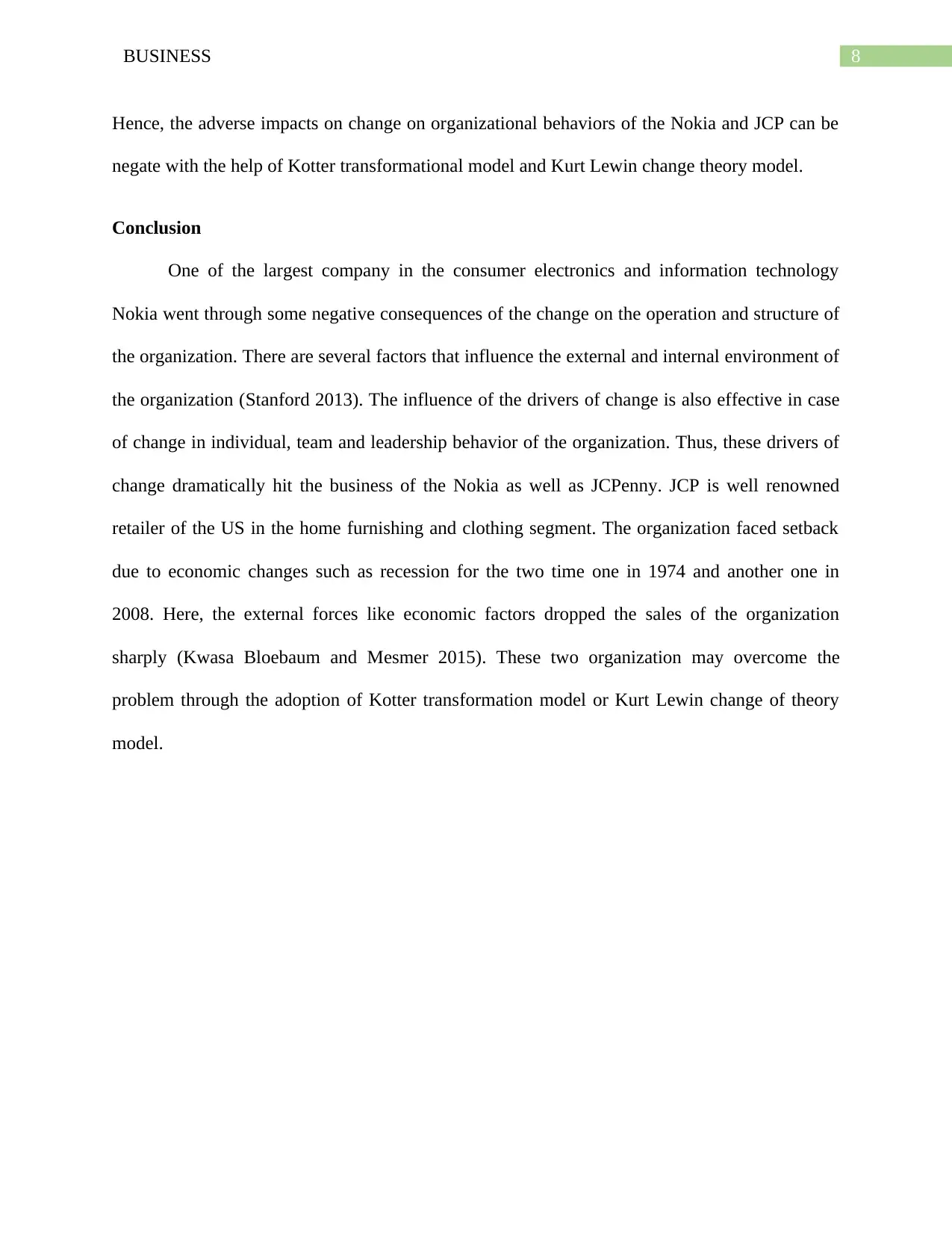
8BUSINESS
Hence, the adverse impacts on change on organizational behaviors of the Nokia and JCP can be
negate with the help of Kotter transformational model and Kurt Lewin change theory model.
Conclusion
One of the largest company in the consumer electronics and information technology
Nokia went through some negative consequences of the change on the operation and structure of
the organization. There are several factors that influence the external and internal environment of
the organization (Stanford 2013). The influence of the drivers of change is also effective in case
of change in individual, team and leadership behavior of the organization. Thus, these drivers of
change dramatically hit the business of the Nokia as well as JCPenny. JCP is well renowned
retailer of the US in the home furnishing and clothing segment. The organization faced setback
due to economic changes such as recession for the two time one in 1974 and another one in
2008. Here, the external forces like economic factors dropped the sales of the organization
sharply (Kwasa Bloebaum and Mesmer 2015). These two organization may overcome the
problem through the adoption of Kotter transformation model or Kurt Lewin change of theory
model.
Hence, the adverse impacts on change on organizational behaviors of the Nokia and JCP can be
negate with the help of Kotter transformational model and Kurt Lewin change theory model.
Conclusion
One of the largest company in the consumer electronics and information technology
Nokia went through some negative consequences of the change on the operation and structure of
the organization. There are several factors that influence the external and internal environment of
the organization (Stanford 2013). The influence of the drivers of change is also effective in case
of change in individual, team and leadership behavior of the organization. Thus, these drivers of
change dramatically hit the business of the Nokia as well as JCPenny. JCP is well renowned
retailer of the US in the home furnishing and clothing segment. The organization faced setback
due to economic changes such as recession for the two time one in 1974 and another one in
2008. Here, the external forces like economic factors dropped the sales of the organization
sharply (Kwasa Bloebaum and Mesmer 2015). These two organization may overcome the
problem through the adoption of Kotter transformation model or Kurt Lewin change of theory
model.
⊘ This is a preview!⊘
Do you want full access?
Subscribe today to unlock all pages.

Trusted by 1+ million students worldwide
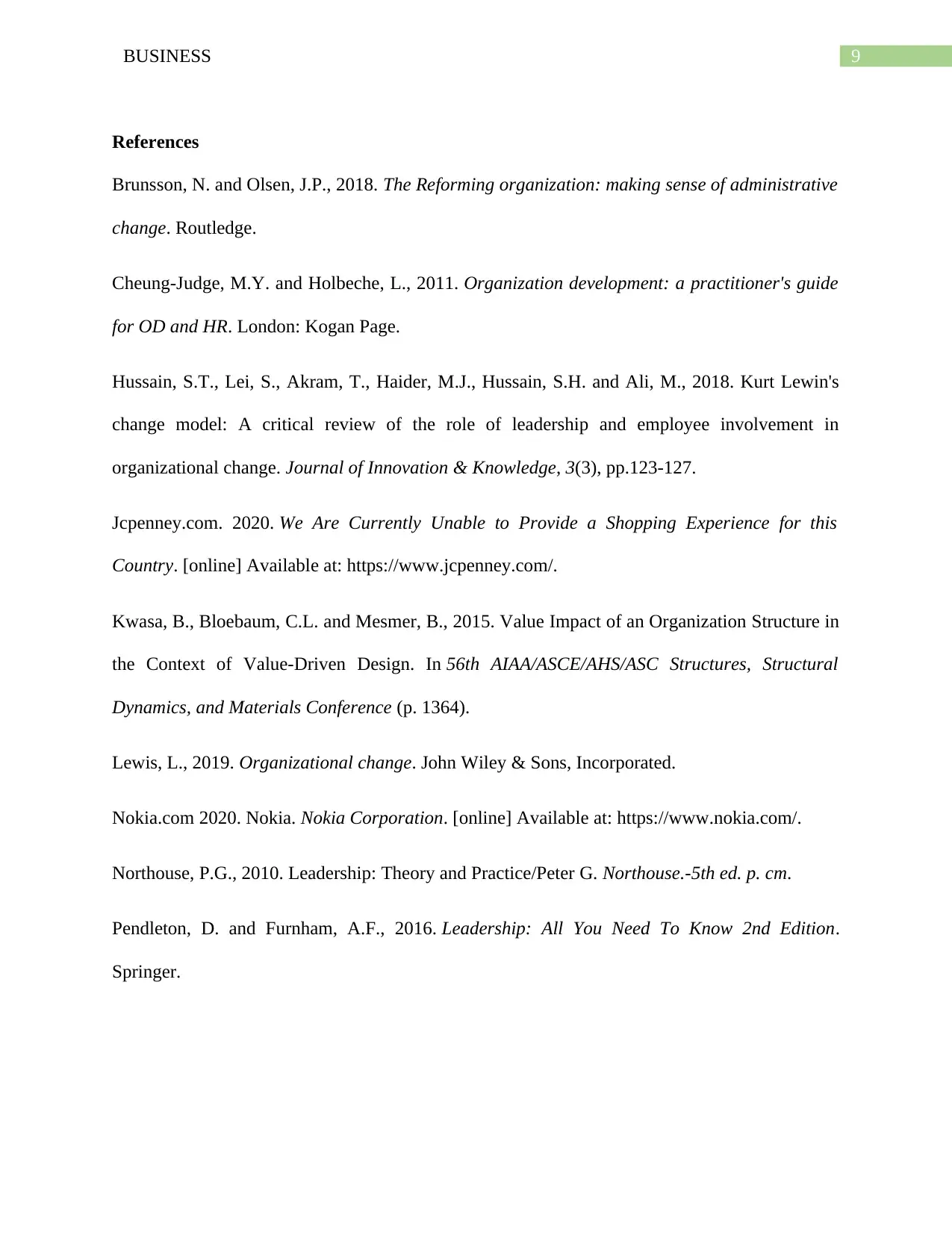
9BUSINESS
References
Brunsson, N. and Olsen, J.P., 2018. The Reforming organization: making sense of administrative
change. Routledge.
Cheung-Judge, M.Y. and Holbeche, L., 2011. Organization development: a practitioner's guide
for OD and HR. London: Kogan Page.
Hussain, S.T., Lei, S., Akram, T., Haider, M.J., Hussain, S.H. and Ali, M., 2018. Kurt Lewin's
change model: A critical review of the role of leadership and employee involvement in
organizational change. Journal of Innovation & Knowledge, 3(3), pp.123-127.
Jcpenney.com. 2020. We Are Currently Unable to Provide a Shopping Experience for this
Country. [online] Available at: https://www.jcpenney.com/.
Kwasa, B., Bloebaum, C.L. and Mesmer, B., 2015. Value Impact of an Organization Structure in
the Context of Value-Driven Design. In 56th AIAA/ASCE/AHS/ASC Structures, Structural
Dynamics, and Materials Conference (p. 1364).
Lewis, L., 2019. Organizational change. John Wiley & Sons, Incorporated.
Nokia.com 2020. Nokia. Nokia Corporation. [online] Available at: https://www.nokia.com/.
Northouse, P.G., 2010. Leadership: Theory and Practice/Peter G. Northouse.-5th ed. p. cm.
Pendleton, D. and Furnham, A.F., 2016. Leadership: All You Need To Know 2nd Edition.
Springer.
References
Brunsson, N. and Olsen, J.P., 2018. The Reforming organization: making sense of administrative
change. Routledge.
Cheung-Judge, M.Y. and Holbeche, L., 2011. Organization development: a practitioner's guide
for OD and HR. London: Kogan Page.
Hussain, S.T., Lei, S., Akram, T., Haider, M.J., Hussain, S.H. and Ali, M., 2018. Kurt Lewin's
change model: A critical review of the role of leadership and employee involvement in
organizational change. Journal of Innovation & Knowledge, 3(3), pp.123-127.
Jcpenney.com. 2020. We Are Currently Unable to Provide a Shopping Experience for this
Country. [online] Available at: https://www.jcpenney.com/.
Kwasa, B., Bloebaum, C.L. and Mesmer, B., 2015. Value Impact of an Organization Structure in
the Context of Value-Driven Design. In 56th AIAA/ASCE/AHS/ASC Structures, Structural
Dynamics, and Materials Conference (p. 1364).
Lewis, L., 2019. Organizational change. John Wiley & Sons, Incorporated.
Nokia.com 2020. Nokia. Nokia Corporation. [online] Available at: https://www.nokia.com/.
Northouse, P.G., 2010. Leadership: Theory and Practice/Peter G. Northouse.-5th ed. p. cm.
Pendleton, D. and Furnham, A.F., 2016. Leadership: All You Need To Know 2nd Edition.
Springer.
Paraphrase This Document
Need a fresh take? Get an instant paraphrase of this document with our AI Paraphraser
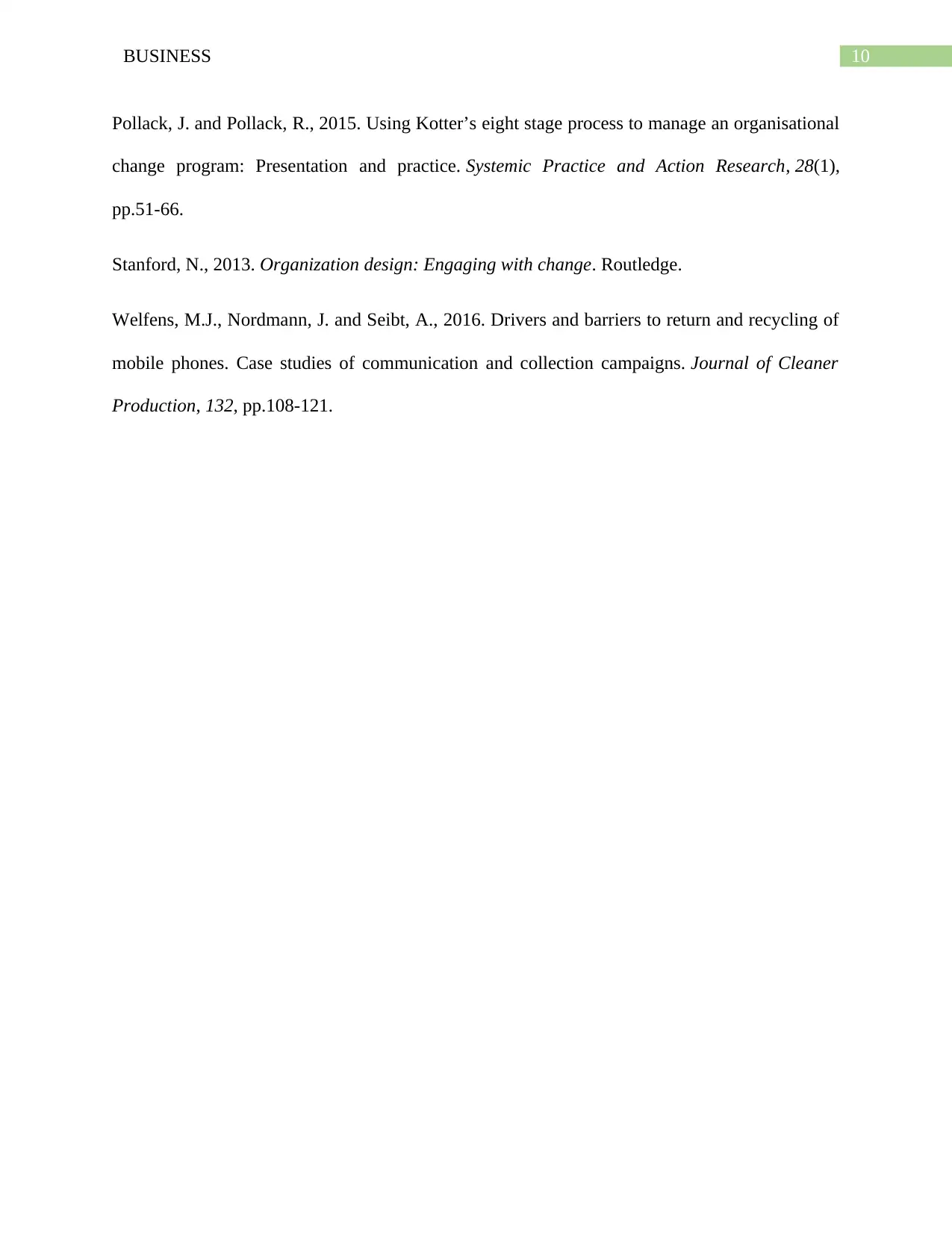
10BUSINESS
Pollack, J. and Pollack, R., 2015. Using Kotter’s eight stage process to manage an organisational
change program: Presentation and practice. Systemic Practice and Action Research, 28(1),
pp.51-66.
Stanford, N., 2013. Organization design: Engaging with change. Routledge.
Welfens, M.J., Nordmann, J. and Seibt, A., 2016. Drivers and barriers to return and recycling of
mobile phones. Case studies of communication and collection campaigns. Journal of Cleaner
Production, 132, pp.108-121.
Pollack, J. and Pollack, R., 2015. Using Kotter’s eight stage process to manage an organisational
change program: Presentation and practice. Systemic Practice and Action Research, 28(1),
pp.51-66.
Stanford, N., 2013. Organization design: Engaging with change. Routledge.
Welfens, M.J., Nordmann, J. and Seibt, A., 2016. Drivers and barriers to return and recycling of
mobile phones. Case studies of communication and collection campaigns. Journal of Cleaner
Production, 132, pp.108-121.
1 out of 11
Related Documents
Your All-in-One AI-Powered Toolkit for Academic Success.
+13062052269
info@desklib.com
Available 24*7 on WhatsApp / Email
![[object Object]](/_next/static/media/star-bottom.7253800d.svg)
Unlock your academic potential
Copyright © 2020–2025 A2Z Services. All Rights Reserved. Developed and managed by ZUCOL.





